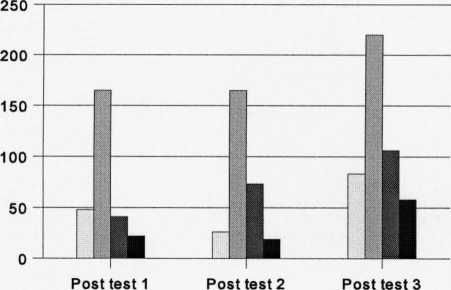Qualitative analysis
Types of justifications
Children Providedjustifications for their associations which were based on different criteria.
The main types Ofjustifications identified are presented in Table 7.14.
Table 7.14 Types of justifications provided in the association task
|
Justifications_____________ |
__________________Example____________________ |
|
NoZirrelevant justification |
If no or an Irrelevantjustification was given E.g. “because they are animals ” ________EgTbecause the stool goes next to a table”________ |
The distribution of children’s justifications for their associations over time was investigated.
Figure 7.18 presents the distribution of children’s responses.
Figure 7.18 Types of justifications provided in the association task across testing

і I NoZirrelevant ∣ ∣ Perceptual
■ Semantic H Thematic
As the above figure shows, children’s justifications were mainly “perceptual”. The second
most frequent type of justification was “semantic”. “Thematic” justifications were also
provided in a few instances. The statistical analysis revealed that children provided
significantly more “perceptual” than “semantic” (Wilcoxon, Pl: Z= 5.4, p<.0000; P2:
Z=4.07, p<.0000; P3: Z=3.7, p<.0005) and “thematic” justifications (Pl: Z=5.8, p<.0000; P2:
Z=6.2, p<.0000; P3: Z=5.9, p<.0000). All the children also provided more “semantic” than
“thematic” justifications during post test 2 (Wilcoxon: Z= 4.1, p<.0000) and post test 3
(Wilcoxon: Z=2.4, p<.05).
240
More intriguing information
1. Sex-gender-sexuality: how sex, gender, and sexuality constellations are constituted in secondary schools2. The name is absent
3. The Complexity Era in Economics
4. WP 1 - The first part-time economy in the world. Does it work?
5. The name is absent
6. Ventas callejeras y espacio público: efectos sobre el comercio de Bogotá
7. Banking Supervision in Integrated Financial Markets: Implications for the EU
8. The name is absent
9. The name is absent
10. European Integration: Some stylised facts